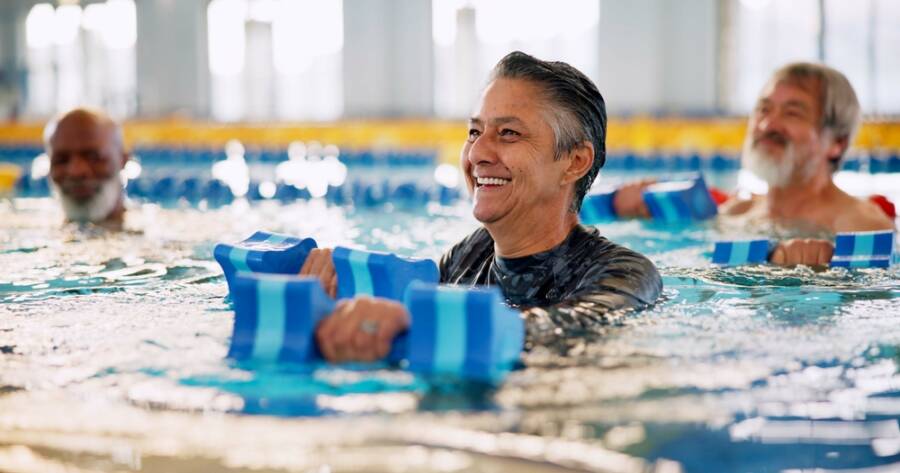Aging is a natural part of life, but maintaining physical health and strength as we age is essential for staying independent and active. Regular exercise can help reduce the risks of chronic conditions, improve mobility, and maintain overall health. By incorporating low-impact activities, strength training, and flexibility exercises into your routine, you can enjoy better physical function and quality of life well into your later years. Explore the best exercises to keep your body strong as you age.
Walking: A Simple Yet Powerful Exercise
Walking is one of the best exercises for older adults due to its low impact and wide range of health benefits. It’s an excellent cardiovascular workout that helps maintain heart health, improves circulation, and reduces the risk of chronic conditions like high blood pressure and diabetes. Walking also helps strengthen bones and muscles without putting excessive strain on joints, making it a safe option for those with arthritis or other joint issues.
For maximum benefit, aim for 30 minutes of brisk walking most days of the week. You can start at a slower pace and gradually increase the intensity. Whether you’re walking outdoors or on a treadmill, this simple exercise helps promote cardiovascular health, boosts mood, and maintains mobility.
Swimming: A Low-Impact, Full-Body Workout
Swimming is a fantastic low-impact exercise that works the entire body while being easy on the joints. The buoyancy of the water reduces the strain on bones and muscles, making it ideal for individuals with arthritis or joint pain. Swimming helps improve cardiovascular health, build muscle strength, and increase flexibility. It also enhances coordination and balance, which are crucial for preventing falls as you age.
Even gentle swimming sessions or water aerobics can provide a full-body workout. Aim for two to three sessions per week, combining swimming with other water exercises for improved strength, endurance, and mobility. The calming effect of water also promotes relaxation, making it a great choice for mental and emotional well-being.
Strength Training: Building Muscle for Longevity
As we age, muscle mass naturally decreases, which can lead to weakness, reduced mobility, and an increased risk of falls. Strength training helps counteract this by building and maintaining muscle mass, improving bone density, and boosting metabolism. Weight-bearing exercises, such as lifting dumbbells, resistance band exercises, or bodyweight movements like squats and lunges, are effective for strengthening muscles and bones.
Strength training should be performed two to three times a week, targeting all major muscle groups. Start with lighter weights or resistance bands and gradually increase the intensity as you build strength. This type of exercise not only helps with physical strength but also promotes functional fitness, allowing you to perform daily tasks with greater ease.
Yoga: Enhancing Flexibility and Balance
Yoga is a great exercise for improving flexibility, balance, and mental well-being. As we age, our joints and muscles naturally become stiffer, and yoga helps counteract this by promoting flexibility through gentle stretching. Regular practice also improves posture, reduces stress, and enhances balance, which can help prevent falls and injuries. Certain yoga poses also strengthen the muscles, particularly those that support the core and back, which are crucial for maintaining good posture and avoiding strain.
You don’t need to be an expert to start yoga! There are many beginner-friendly classes or online videos available that focus on gentle stretches and breathing techniques. Practice yoga two to three times a week to improve flexibility, strength, and overall well-being.
Tai Chi: A Gentle Way to Improve Balance and Strength
Tai Chi is an ancient Chinese martial art that involves slow, deliberate movements and deep breathing. It’s a low-impact exercise that’s particularly beneficial for improving balance, coordination, and muscle strength. Tai Chi can help reduce the risk of falls by promoting better stability and awareness of body movements. The gentle motions also help improve circulation and reduce stress, making it an excellent option for older adults looking to enhance both their physical and mental health.
Aim to practice Tai Chi at least twice a week. There are many classes available, or you can follow along with instructional videos. As you progress, the movements will become more fluid, helping to build both strength and balance over time.
Stretching: Maintaining Flexibility and Range of Motion
Maintaining flexibility is crucial as we age, and stretching is one of the best ways to keep your muscles long and joints mobile. Stretching improves the range of motion, which helps maintain independence and flexibility for everyday activities, such as bending down or reaching overhead. Focus on stretching major muscle groups, especially those that can become tight with age, such as the hamstrings, calves, and lower back.
Incorporate stretching into your routine after any workout or physical activity, and aim for at least 5-10 minutes of gentle stretching each day. Stretching helps improve circulation, reduce muscle tension, and prevent stiffness, all of which contribute to better overall mobility and physical function.
Maintaining Strength and Mobility for a Healthy Future
By integrating these exercises into your daily routine, you’ll be setting yourself up for a healthier, stronger future. Regular physical activity not only strengthens muscles and bones but also improves balance, flexibility, and cardiovascular health, which are essential for maintaining mobility and independence as you age.
Whether you choose walking, swimming, strength training, or yoga, consistency is key to reaping the benefits. Stay active, listen to your body, and enjoy the journey to a long, healthy life.

